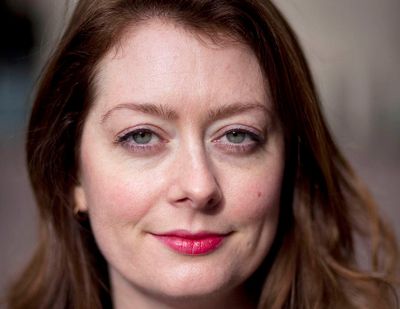Louise O’Kelly

An independent curator and arts professional based in London, Louise O’Kelly is the founding director of Block Universe, London's only performance art festival. The festival aims to present work by some of the most exciting UK-based and international performance artists practicing today.
Under the theme of The Future Perfect, the festival recently opened its second iteration (30 May to 5 June 2016) and this year presentations by artists will take place at venues across the city such as the British Museum, David Roberts Art Foundation, ICA, Royal Academy of Arts, Sadler’s Wells and Somerset House, as well as other off-site locations.
In this Ocula Conversation, O’Kelly discusses her reasons for founding the festival, and in particular how she felt it necessary to provide a vehicle for promoting performance in a city where there is a distinct lack of support for the art form.
SSSo tell me a bit about Block Universe? How long have you been interested in doing this type of event?
LOKPerformance art is something I’m really passionate about. I did my MA in contemporary art theory with a focus on performance and dance. Before doing this, I had been working with the estates of artists like Hannah Wilke, Ana Mendieta and Lygia Clark, so that helped spark my interest. Obviously they were super cool women creating amazing performance and participatory art.
If you look at perfomance art in London, we don’t have a single dedicated venue for it. And if you’re looking at how it’s being programmed, for the most part, well we had Tate Tanks when it was open, but beyond that there aren’t really any venues. In the last few years there has been a greater interest and hunger for performance, but we are mainly limited to seeing a performance at an opening or as an ‘add-on’ to a main show. From talking to different artists, I realised there was a general lack of understanding from galleries or institutional venues for the requirements of bodies in space. Originally I was imagining a kind of seminar or conference, but then I realised that you just can’t talk about it without showing it. I guess then I had my lightbulb moment! [laughs]
SSDo you think it's better served in other countries?
LOKYes, I do.
New York has Performa and also dedicated venues such as The Kitchen. There are also numerous venues that engage with performance or contemporary dance. In most European cities, as well.
SSReally? That goes to show how much I know.
LOKIt has been a real learning curve since I started developed Block Universe. There are numerous festivals throughout Europe. In Sweden, say, I went to visit MDT in Stockholm, which has a really strong scene in performance. Mårten Spångberg was teaching at the university there, so there is a wave of inspired young artists coming out of the school. In Sweden performance art projects are also likely to be better funded than in the UK.
A space like MDT has several different rooms to present performance-oriented work. And because they have the resources, artists can spend weeks on end creating a work in the space, trying out lighting, sound, whatever they need to fully realise a piece. Artists working on performance in London, by contrast, almost by default have kind of lo-fi performances, because they don’t have access to the funds or resources like rehearsal spaces to experiment.
SSI think as an artist, you respond to your situation. And in this case, I imagine it should generate another kind of performance art. Perhaps one right for this place and time. As for rehearsal spaces, performance art didn’t originally come to be for that … But I think it has become much more like theatre in the last few decades.
LOKIn the UK, even with Block Universe we show a lot of choreography crossover works. I see it as people working with dance in a more conceptual way, that is more accepted in contemporary art. But you’re right, the UK has a really strong theatre tradition, and a strong history of experimental theatre.
SSI think in general the visual arts are becoming more theatrical across the board.
LOKI think that could be fair to say.
SSBut performance art doesn't always need an audience, does it? I think of performance coming about from interventions or a kind of anti-object art. I’m also thinking of Allan Kaprow or Chris Burden… Ana Mendieta didn’t really have an audience.
LOKYes, but she was specifically performing to camera. Even if she didn’t have physical presence there, she always had an audience in mind. And if you were thinking of performative actions that happened in Eastern Europe say in the Soviet era, their artistic expression was somewhat censored or mitigated. So there were a lot of people who did certain actions which were or weren’t documented. Some of them were photographs or letters, these kinds of things. That’s a way of performing.
SSIt seems to me it’s more performative in the way of theatre or music where there’s an audience. Whereas for older artists like Kaprow or Burden they were more like interventions or actions. In Happenings, viewers could be participants, whereas now ...
LOKI think yes and no. Yes, I agree in the sense that in such a mediated society everyone is attuned to visual imagery, and more performances now involve music or dance and so on. But I think there’s also a lot that doesn’t necessarily fit into that category. There are many different types of performance. For example, there are artists who use the dancer’s body as their medium. Then there are other artists, such as Philip Ewe, who’s in the Block Universe programme this year and his work is a one-man sort of monologue. But at the same time what he does rather than performing as a visual experience, well ... he calls it 'talking to fill a room.' I see it as controlling the emotional temperature in a space. For me, that’s an experience that the audience is a part of, rather than a spectacle. 
SSTell me about how you pulled Block Universe together. Did you pick up a phone and say, ‘I need five venues … I’ve got these guys … ’?
LOKI would say that the only way it happened was through blind faith. Yes, that literally it. To start off, I had strong support from very good friends who were willing to get their venues on board with this. Sadly, one didn’t come about because of the change of program, but that happens too. Honestly, I think it’s really blind faith, and calling in a hell of a lot of favours. A lot of support in kind from enthusiastic supporters, to whom we are very grateful. I am lucky to have several dedicated staff members who volunteer their time to work tirelessly to produce the festival, liase with artists and venues, and we also have to work hard to raise enough additional funding to pay for the real necessities, like the artists’ fees, performers, travel and production costs, documentation and promotion.
SSHow do you see yourself in relation to other festivals? Like Performa?
LOKInternationally? Well, for a start, I don’t know if there’s a huge difference, but Performa, say, commission visual artists who haven't done performance before. I guess my remit here in London is to support artists already working in performance, people that are already making this kind of work, and to create opportunities for them, to give them a platform, visibility. Commissioning new pieces and finding the right venues, say black box spaces or otherwise.
SSThat’s work!
LOKYes, that’s why our venues are such a crazy mix. There’s a pairing that happens. If it’s a pre-existing work that we’re bringing to London from abroad, we have to find a space appropriate for that. If it’s a new work, we have to find the right context for what it is going to be. If it isn’t in a gallery or black box space, what kind of space does it need? The variety can be exhilarating. This year, we have works happening in Kachette, which is a space underneath railway arches in Old Street. Alexis Blake has created a work wthat will take place in the amazing Parthenon galleries at the British Museum. Philip Ewe's performance will take place on the 8th floor of an office building overlooking Kings Cross. Grace Schwindt is doing two outdoor performances, one in the Royal Academy courtyard and another in a garden in Mayfair. It's a real mix.
SSAs director do you curate your festival? That must be the pleasure of the job.
LOKYes, I do, and it is. In the first few years, it’s important to establish an identity, especially for the kind of art we're showing. I really enjoy finding the artists and talking about the ideas with them. Figuring out how they fit into the festival's theme or finding a unifying factor. Sometimes that’s a way to choose artists whose work may be appropriate, or if you’re producing something new, it can feed into ideas. So yes, that’s a very rewarding part of our work.
SSWhat is your theme this year?
LOKThis year it is ‘The Future Perfect’. Last year we didn’t discuss on the theme widely, but essentially it was about legacies of performance, which looked at how we sustain an engagement with performance after the moment of it's passing. We were looking at the body as archive or the body as memory. In a way, we were looking at the types performance that were designed to repeat, for example choreography, rehearsal and repetition, oral history, storytelling, song and things that exist in the body and can be accessed through performance. Which leads me to the inspiration for the name of the festival.
‘Block Universe’ is a physics theory which describes an alternative theory of time. Rather than the teleological version where we come from the big bang and move forward into an expanding universe, instead space and time already exist in the universe, which means that the past, present and future exist simultaneously. So playing with that as a basis, ‘future perfect’ can even be the ‘future present’. How moments overlap, this relationship between the future and the body. It’s been really exciting to see how the different artists have come round to approaching that. It's very much about our relationship to technology, the body, going into cyborg or constructed identities. A lot of artists such as niv Acosta, who looks at Afro-Futurism in terms of his own identity. Lina Hermsdorf is creating a work concerned with ageing and immortality, how to cure ageing, or to regenerate our bodies. Topics like self-improvement or the perfect self have arisen. The idealised body in Greek and Roman culture. What is the perfect body in the current moment?
SSSince you studied performance, do you think things have changed? What is performance now?
LOKHow it looks is quite different, but I think that it’s dealing with some of the same issues. A lot of it is about identity politics, body politics. I do feel like this is an interesting moment in time. Performance may be more theatrical or spectacular in some ways. I feel that there is a really new wave of what performance can be. At the same time, I feel that it also harks back to the 60s and 70s in New York, when contemporary dancers were hanging out with visual artists, and those conversations lead to exciting and influential work. That became what we know today as contemporary art. I think a lot of that energy is happening again, in terms of interdisciplinary thinking and crossing over. —[O]








